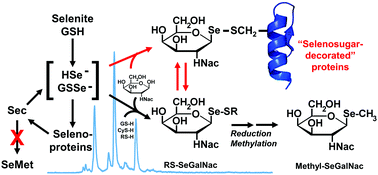Identification and determination of selenocysteine, selenosugar, and other selenometabolites in turkey liver†
Abstract
Liver and other tissues accumulate selenium (Se) when animals are supplemented with high dietary Se as inorganic Se. To further study selenometabolites in Se-deficient, Se-adequate, and high-Se liver, turkey poults were fed 0, 0.4, and 5 μg Se g−1 diet as Na2SeO3 (Se(IV)) in a Se-deficient (0.005 μg Se g−1) diet for 28 days, and the effects of Se status determined using HPLC-ICP-MS and HPLC-ESI-MS/MS. No selenomethionine (SeMet) was detected in liver in turkeys fed either this true Se-deficient diet or supplemented with inorganic Se, showing that turkeys cannot synthesize SeMet de novo from inorganic Se. Selenocysteine (Sec) was also below the level of detection in Se-deficient liver, as expected in animals with negligible selenoprotein levels. Sec content in high Se liver only doubled as compared to Se-adequate liver, indicating that the 6-fold increase in liver Se was not due to increases in selenoproteins. What increased dramatically in high Se liver were low molecular weight (MW) selenometabolites: glutathione-, cysteine- and methyl-conjugates of the selenosugar, seleno-N-acetyl galactosamine (SeGalNac). Substantial Se in Se-adequate liver was present as selenosugars decorating general proteins via mixed-disulfide bonds. In high-Se liver, these “selenosugar-decorated” proteins comprised ∼50% of the Se in the water-soluble fraction, in addition to low MW selenometabolites. In summary, more Se is present as the selenosugar moiety in Se-adequate liver, mostly decorating general proteins, than is present as Sec in selenoproteins. With high Se supplementation, increased selenosugar formation occurs, further increasing selenosugar-decorated proteins, but also increasing selenosugar linked to low MW thiols.



 Please wait while we load your content...
Please wait while we load your content...